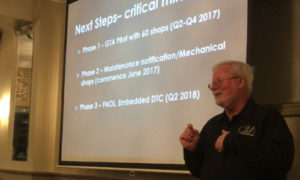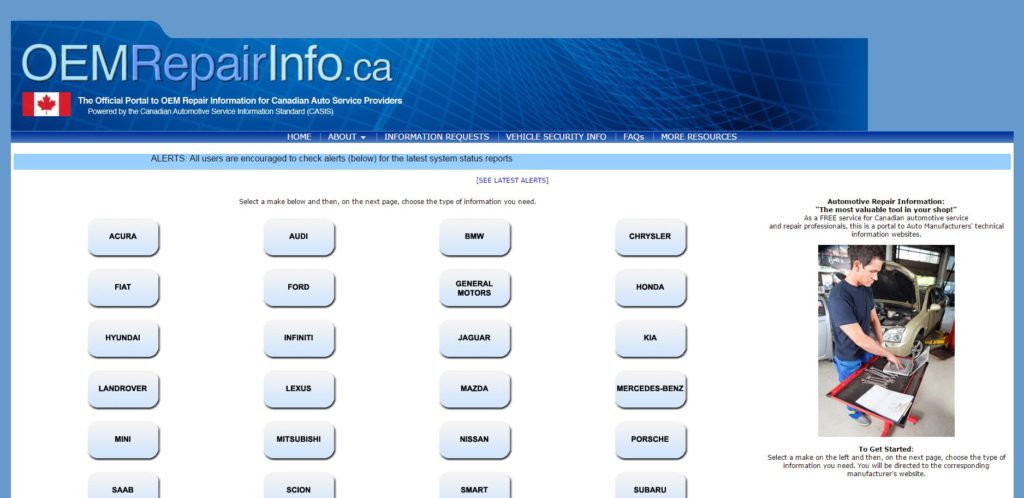
Collision Repair Magazine, CIIA: Road Trust ‘accreditation program with teeth’ moves forward in Canada
By onAssociations | Business Practices | International | Market Trends | Repair Operations
The Collision Industry Information Assistance trade group last month updated the Canadian auto body repair industry on the Road Trust service, which CIIA’s executive director describes as an “accreditation program with teeth.”
Road Trust was developed in conjunction with the startup Ckure. Customers use Ckure’s app to summon assistance after a collision — the app doesn’t detect a crash, unlike similar services — and connect the driver with a shop which truly is qualified to do the repair, according to CIIA Executive Director John Norris.
“Motorists involved in an accident will get automatic phone notifications of what to do and an actual personal call from the accredited shop within 30 seconds,” Norris wrote. The repairer responds immediately and sends a tow.
Last year, the program was described as by default connecting customers to the shop which persuaded them to install the app, assuming the customer didn’t manually input a different preferred shop to be the default.
“This program brings the customer to the shop they want to use, not to an insurance company, tow truck operator, or where the OEM may have negotiated with an insurer or certified shop that want them as a customer,” Norris wrote. “Isn’t that what we all wanted to have? A customer makes the decision.”
If the default wasn’t available, the app shows nearby Road Trust-approved shops.
“Shops are audited to ensure (they) are following OEM standards, information, scanning and repair levels,” Norris wrote in an email. He called this condition “OEM compliant,” describing it as “a lot easier and cheaper” than OEM certification.
However, “easy” here assumes the shop knows how to fix vehicles properly — and can prove it. If not, don’t expect to make the cut, according to Norris. He wrote that “These are not equipment standards and we walk away,” nor is it a matter of paying a fee and automatically being accepted.
“We are checking labour standards, trades qualification levels and legal compliancy here including skills competence,” he wrote. It’s an “accreditation program with teeth (audited and mandatory and checked),” he wrote.
Shops must look up OEM procedures and post-repair scan vehicles with what CIIA describes as a “ROADTRUST authorized scanning system” that “uses OEM scanners.” The scans are provided to insurers, customers and OEMs which would like to see the results.
“With sharing scan data and in some cases having scan data going to the customer’s cell phone, (and to the OEM) we have made the customer the final auditor of shop performance and shops can now concentrate on pleasing the customer and performing a proper repair,” Norris wrote.
“Copies of scans can go to the OEM,” Norris wrote. “We are working on how access to OEM sites can be better monitored.”
However, according to CIIA, shops should be looking up the data by using the recently redesigned CASIS portal, which provides convenient links to automakers’ repair information websites.
The new www.OEMRepairInfo.ca site combines elements of the U.S. OEM1Stop, a joint effort by NASTF and automakers, but also the I-CAR’s Repairability Technical Support portal, which explains to shops how to find the repair information once they’re on OEM technical sites.
It also conveniently contains a rolling log of alerts and updates.
Our Canadian content partner Collision Repair Magazine last month covered a CIIA presentation of the program. According to the magazine’s Jan. 18 coverage here, the audience included “multiple shop owners and banner store staff, an enforcement officer from the College of Trades, and even out of town shop owners eager to learn about the Roadtrust collision repair shop accreditation program with the linked telephone app that retains existing customers and attracts new customers.”
It also observed the program’s similarities to other Canadian certification initiatives: “According to John Norris of CIIA, the actual collision repair shop standards have not changed and the standards used by Roadtrust are very similar to the programs offered by ARA of British Columbia and the CCIAP program offered by AIA Canada.”
However, CIIA also pointed out some of the “challenges” other certification or direct repair programs might have, calling Roadtrust a way of avoiding these doubts:
-some insurers (work) hard to not send cars to accredited shops fearing higher repair costs
-OEMs have valid suspicions that accredited shops are not looking up OEM repair data nor using OEM repair equipment or repair methods
-Insurers often believe that they are being charged for scanning services not provided or poorly provided
-shops purchase expensive equipment and find their investments generate poor returns as new customers do not materialize
-consumers are confused and often mis-directed
“We believe that this program is a viable and positive answer to many concerns about shop accreditation,” CIIA also wrote. “ROADTRUST! wants to ensure that customers, OEMs and insurers trust the competence, value and compliance skills of your shop.”
Read more from Collision Repair magazine here.
An application for a Road Trust pilot program and what you need to be a Road Trust shop can be found here.
More information:
“CIIA hosts Roadtrust accreditation meeting”
Collision Repair Magazine, Jan. 18, 2017
Collision Industry Information Assistance letter on Roadtrust
CIIA, January 2017
Canadian OEM Repair Info website
Images:
Collision Industry Information Assistance Executive Director John Norris gives a presentation on Roadtrust in January 2017. (Provided by CIIA via Collision Repair Magazine)
The new www.OEMRepairInfo.ca site combines elements of the U.S. OEM1Stop, a joint effort by NASTF and automakers, but also the I-CAR’s Repairability Technical Support portal, which explains to shops how to find the repair information once they’re on OEM technical sites. (Screenshot from www.oemrepairinfo.ca)

